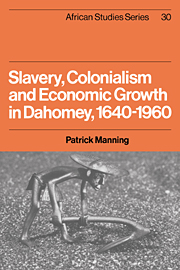Book contents
- Frontmatter
- Contents
- Maps
- Tables
- Figures
- Preface
- 1 Slavery, colonialism and economic growth, 1640–1960
- 2 The Dahomean economy, 1640–1890
- 3 Struggles with the gods: economic life in the 1880s
- 4 Production, 1890–1914
- 5 Demand, 1890–1914
- 6 Exchange, 1890–1914
- 7 The alien state, 1890–1914
- 8 Social struggles for economic ends, 1890–1914
- 9 The mechanism of accumulation
- 10 Capitalism and colonialism, 1915–60
- 11 The Dahomean national movement
- 12 Epilogue
- Notes
- Appendix 1 Export revenue from Dahomey, 1640s–1950s
- Appendix 2 Slave exports by ethnic origin
- Appendix 3 Population loss due to slave exports
- Appendix 4 Foreign trade of Dahomey
- Appendix 5 Foreign trade indices
- Appendix 6 Rainfall
- Appendix 7 Fiscal flows
- Appendix 8 Money supply of colonial Dahomey
- Bibliography
- Index
7 - The alien state, 1890–1914
Published online by Cambridge University Press: 26 October 2009
- Frontmatter
- Contents
- Maps
- Tables
- Figures
- Preface
- 1 Slavery, colonialism and economic growth, 1640–1960
- 2 The Dahomean economy, 1640–1890
- 3 Struggles with the gods: economic life in the 1880s
- 4 Production, 1890–1914
- 5 Demand, 1890–1914
- 6 Exchange, 1890–1914
- 7 The alien state, 1890–1914
- 8 Social struggles for economic ends, 1890–1914
- 9 The mechanism of accumulation
- 10 Capitalism and colonialism, 1915–60
- 11 The Dahomean national movement
- 12 Epilogue
- Notes
- Appendix 1 Export revenue from Dahomey, 1640s–1950s
- Appendix 2 Slave exports by ethnic origin
- Appendix 3 Population loss due to slave exports
- Appendix 4 Foreign trade of Dahomey
- Appendix 5 Foreign trade indices
- Appendix 6 Rainfall
- Appendix 7 Fiscal flows
- Appendix 8 Money supply of colonial Dahomey
- Bibliography
- Index
Summary
The colonial state of Dahomey differed from the states which the French had conquered and absorbed. It was greater in scale and more modern in its techniques of administration, though it adopted many policies and institutions from the prior system. Most fundamentally, however, the new government was alien: the colony of Dahomey was a distant province in a far-flung empire, ruled by authorities who looked to Paris for direction, inspiration, and recognition. Government by consent of the governed was a thing of the past and, perhaps, of the future. The people of Dahomey maintained the power to threaten revolt – a threat made good often enough to remain credible – and the power to slow down those processes of government which could not work without them. Some could act as favored collaborators, building their illusory power on the real threats and pressures of their countrymen. But no Dahomeans, not even the most autocratic and unrepresentative faction, nor the most loyal and Westernized servants, had any constitutional power. The French governed in Dahomey by a political theory in conflict with that of the French Republic, and in conflict as well with the political outlook of their Dahomean subjects. The ideological dispute between the rulers and the ruled was an important dimension of the colonial experience – bit by bit, Dahomeans were able to gain real constitutional authority and to win concessions in political theory. But in the beginning of the colonial era and for many years thereafter, they were conquered peoples.
- Type
- Chapter
- Information
- Slavery, Colonialism and Economic Growth in Dahomey, 1640–1960 , pp. 162 - 186Publisher: Cambridge University PressPrint publication year: 1982

